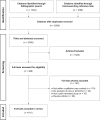Naming racism as a root cause of inequities in palliative care research: a scoping review
- PMID: 38858646
- PMCID: PMC11163751
- DOI: 10.1186/s12904-024-01465-9
Naming racism as a root cause of inequities in palliative care research: a scoping review
Abstract
Background: Racial and ethnic inequities in palliative care are well-established. The way researchers design and interpret studies investigating race- and ethnicity-based disparities has future implications on the interventions aimed to reduce these inequities. If racism is not discussed when contextualizing findings, it is less likely to be addressed and inequities will persist.
Objective: To summarize the characteristics of 12 years of academic literature that investigates race- or ethnicity-based disparities in palliative care access, outcomes and experiences, and determine the extent to which racism is discussed when interpreting findings.
Methods: Following Arksey & O'Malley's methodology for scoping reviews, we searched bibliographic databases for primary, peer reviewed studies globally, in all languages, that collected race or ethnicity variables in a palliative care context (January 1, 2011 to October 17, 2023). We recorded study characteristics and categorized citations based on their research focus-whether race or ethnicity were examined as a major focus (analyzed as a primary independent variable or population of interest) or minor focus (analyzed as a secondary variable) of the research purpose, and the interpretation of findings-whether authors directly or indirectly discussed racism when contextualizing the study results.
Results: We identified 3000 citations and included 181 in our review. Of these, most were from the United States (88.95%) and examined race or ethnicity as a major focus (71.27%). When interpreting findings, authors directly named racism in 7.18% of publications. They were more likely to use words closely associated with racism (20.44%) or describe systemic or individual factors (41.44%). Racism was directly named in 33.33% of articles published since 2021 versus 3.92% in the 10 years prior, suggesting it is becoming more common.
Conclusion: While the focus on race and ethnicity in palliative care research is increasing, there is room for improvement when acknowledging systemic factors - including racism - during data analysis. Researchers must be purposeful when investigating race and ethnicity, and identify how racism shapes palliative care access, outcomes and experiences of racially and ethnically minoritized patients.
Keywords: Health equity; Palliative care; Race and ethnicity; Racism.
© 2024. The Author(s).
Conflict of interest statement
The authors declare no competing interests.
Figures



Similar articles
-
Racial Health Equity and Social Needs Interventions: A Review of a Scoping Review.JAMA Netw Open. 2023 Jan 3;6(1):e2250654. doi: 10.1001/jamanetworkopen.2022.50654. JAMA Netw Open. 2023. PMID: 36656582 Free PMC article.
-
Racism in Pediatric Serious Illness and Palliative Care: A Scoping Review of Qualitative Research.J Pain Symptom Manage. 2025 Jan;69(1):44-52. doi: 10.1016/j.jpainsymman.2024.09.021. Epub 2024 Oct 1. J Pain Symptom Manage. 2025. PMID: 39362386
-
Perinatal Opioid Use Disorder Research, Race, and Racism: A Scoping Review.Pediatrics. 2022 Mar 1;149(3):e2021052368. doi: 10.1542/peds.2021-052368. Pediatrics. 2022. PMID: 35156121 Free PMC article.
-
Diversity, Equity, Inclusion, and Antiracism Research in Physical Therapy Over the Last 25 Years: A Scoping Review.Phys Ther. 2024 Oct 2;104(10):pzae072. doi: 10.1093/ptj/pzae072. Phys Ther. 2024. PMID: 38769877
-
Barriers to and opportunities for advancing racial equity in cervical cancer screening in the United States.BMC Womens Health. 2024 Jun 21;24(1):362. doi: 10.1186/s12905-024-03151-7. BMC Womens Health. 2024. PMID: 38907205 Free PMC article.
References
Publication types
MeSH terms
LinkOut - more resources
Full Text Sources
Medical

